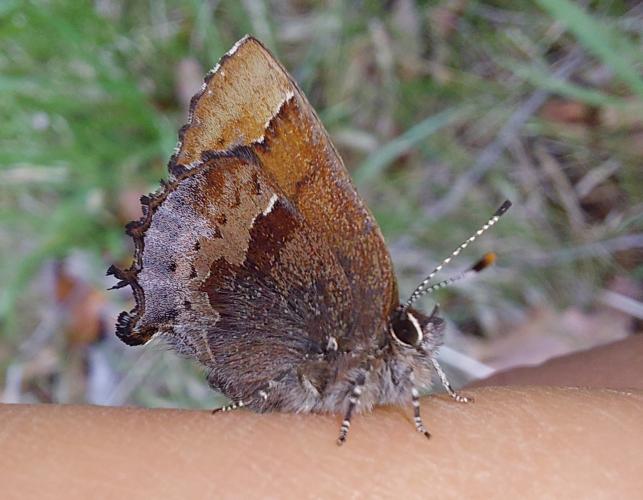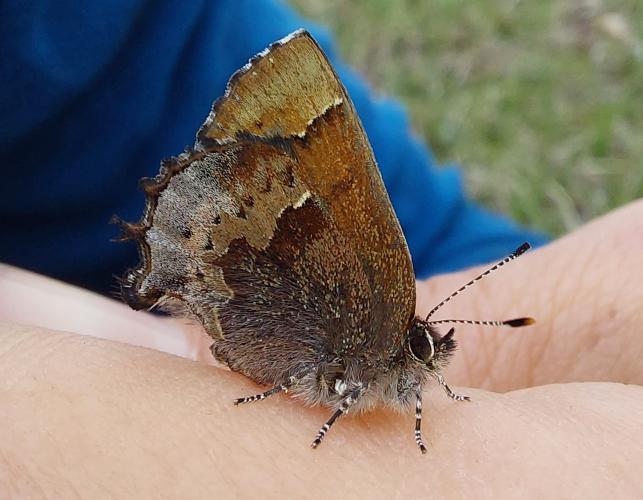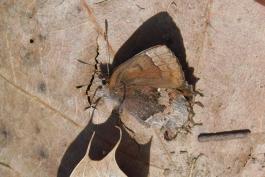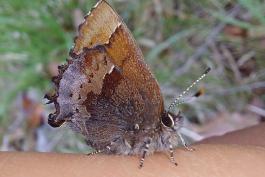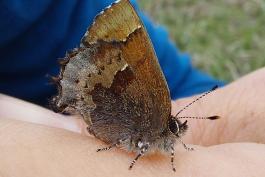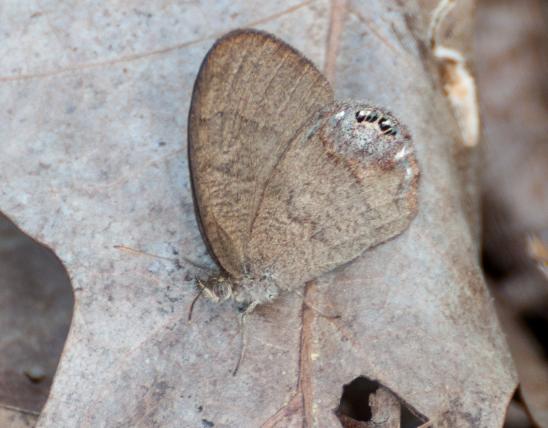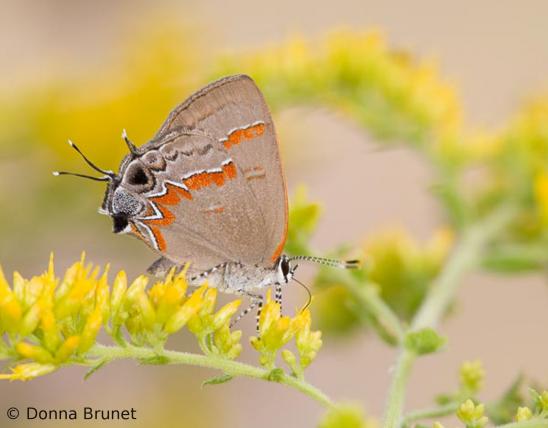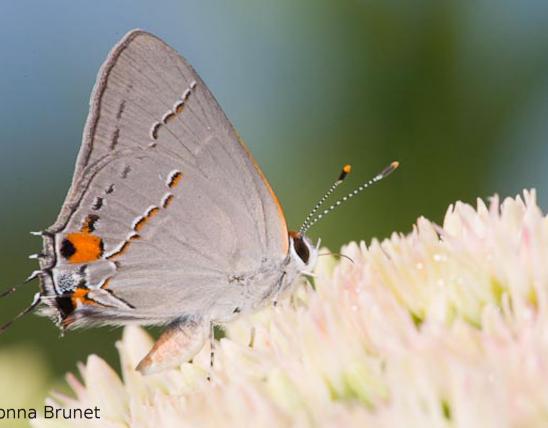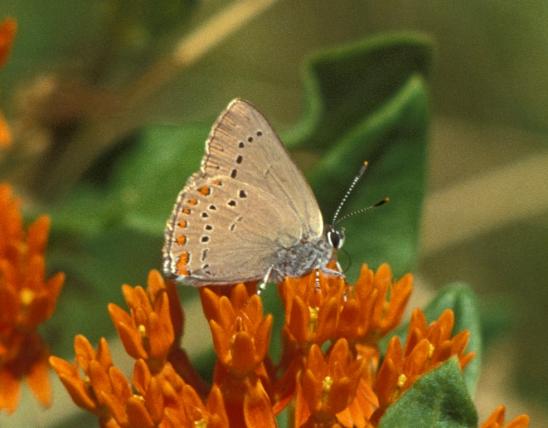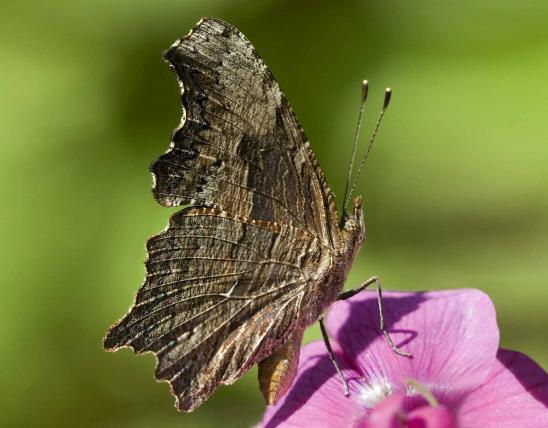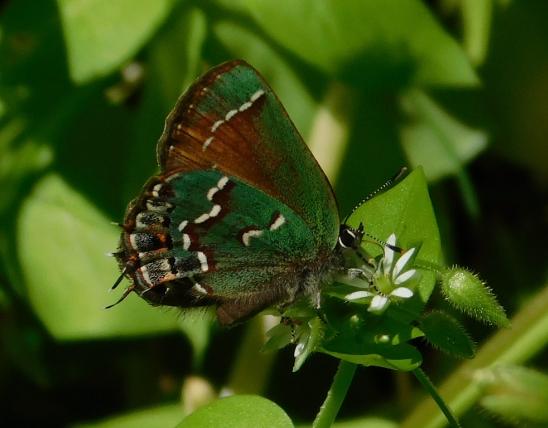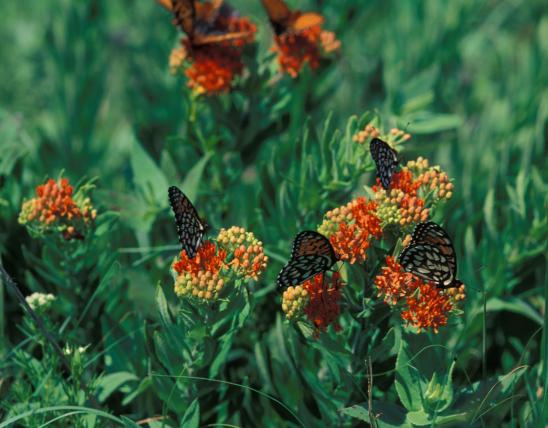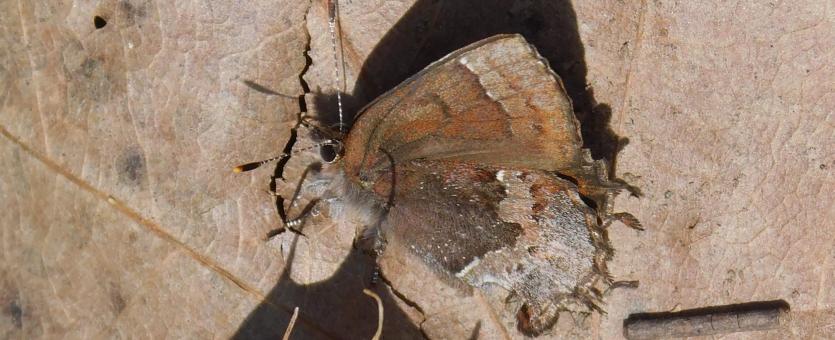
Henry’s elfin adults are small brown butterflies with splendid markings that camouflage them against tree bark. They are fast and erratic fliers. There are short tails on the hindwing. The undersides of the wings have the basal half darker than the outer half. The boundary line between these sections is usually fairly straight on the forewing, while on the hindwing it is uneven. The boundary is outlined with darker brown and white. On the hindwing underside, the outer half is a collage of frosty gray, yellow brown, and rusty brown patches, usually with a series of dark spots. It is rarely seen with the wings held open.
The caterpillars have variable color, starting off as light green but changing to reddish brown before pupating. There is a dorsal stripe and oblique side lines of paler color.
Similar species: The eastern pine elfin (C. niphon) lacks hindwing tails, and the hindwing is distinctively marked with a number of irregular dark brown bands. Adults love to nectar on pussytoes flowers. Its larvae feed on pines, so this species is usually found in or near pine woods, while Henry’s elfin is more closely associated with deciduous woods.
Two other closely related elfins seem to be less common or mostly absent from Missouri, though you may see them in some nearby states; both of them have an irregular boundary line on the forewing underside: the frosted elfin (C. irus) has more frosted color and has a dark spot on the hindwing, near the tails; the brown elfin (C. augustinus) lacks tails and is more uniformly brown and lacks frosting.
Wingspan: ¾–1¼ inches.
Statewide.
Habitat and Conservation
Found mostly in deciduous wooded or woodland-border habitats. Henry’s elfin occurs in local colonies in open woodland and nearby brushy areas. In Missouri Henry’s elfin flies only in April and early May. Watch for this species when redbud and wild plum trees are in full bloom. Males perch on leaves, sometimes at the top of medium-sized trees, so if you want to see them at eye-level, try looking for them on flowers; females are found on the food plants or visiting a variety of flowers for nectar.
Food
Caterpillar food plants include redbud, wild plum, blueberries and their relatives (Vaccinium spp.), and holly (Ilex spp.). The larvae eat the flowers, fruits, and perhaps the leaves of the food plant.
In any given region within its overall range, Henry’s elfin tends to stick to a single food plant or just a few food plants. In some areas in North America, the food plant is unknown.
Status
Single-brooded resident.
Life Cycle
A single-brooded resident (it has only one generation per year). In our state, the adults fly only during April and early May. The eggs are laid singly among the flowers and buds of the food plant. This species overwinters in the pupal stage, hidden among leaf litter on the ground.
Human Connections
This is one of several butterflies and moths that grab our attention in the heart of springtime. If you're into butterfly watching or photography, they're a welcome sight after a long winter. Other April butterflies and moths to look for include the spring azure, gemmed satyr, falcate orangetip, grapevine epimenis, Horace's duskywing and cobweb skippers, eastern tiger and zebra swallowtails, and the pine elfin.
Henry’s elfin populations may be increasing in the U.S. northeast because of the spread of nonnative, invasive common buckthorn (also called European buckthorn, Rhamnus cathartica). It is one of several species that is a suitable host plant for Henry’s elfin, and it was introduced to North America as an ornamental shrub. The elfins in those regions seem to have switched from their native local food plants to the nonnative one. Common buckthorn has proven to be invasive, and it is poisonous if eaten. If you're planting shrubs, choose native ones such as fragrant sumac, winterberry holly, or spicebush.
Ecosystem Connections
Henry’s elfin populations are closely linked to certain, limited types of food plants. Habitat changes that decrease the abundance of their specific food plants can cause declines in the butterfly on a local or regional scale.
Henry’s elfin and other woodland butterflies and moths that are caterpillars in early spring may be zapped when people spray trees with Bacillus thuringiensis (Bt), a bacterial insecticide that is often used against the invasive spongy moth. This is especially the case in states infested by the spongy moth.

